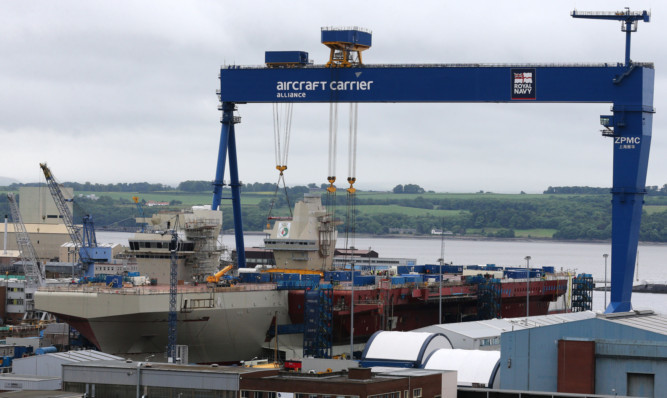The UK’s biggest aircraft carrier has moved a step closer to completion after its 750-tonne control tower was lowered on to the deck.
The aft island of HMS Queen Elizabeth was built in a yard on the River Clyde in Glasgow and sailed on a barge to Rosyth, Fife, last week to join the other parts of the ship.
It took workers in Scotstoun nearly two years to build the section which will serve as the centre of on-board flight operations.
A huge crane lifted it into place last night, and it was then lowered on to the deck today in a ceremony with representatives from the armed forces in attendance.
A plaque with the badges of the Royal Navy, the Army and the RAF was placed under the aft island before it was lowered the final few feet into position.
https://youtube.com/watch?v=jv0eueETrCE
Part of the plaque will remain visible and reads: “Embedded within are the emblems of the Royal Navy, the Royal Air Force and the British Army, the three services which together protect the United Kingdom, her overseas territories and crown dependencies across the globe.”
Two apprentices, Gordon Currie and Chris McArthur, sounded airhorns to signal the start of the lowering.
HMS Queen Elizabeth and another aircraft carrier, HMS Prince of Wales, are the largest warships ever constructed for the Royal Navy. The first is due to be launched in 2016.
They are being built by the Aircraft Carrier Alliance, a partnership of BAE Systems, Babcock, Thales and the Ministry of Defence.
Captain Simon Petitt, senior naval officer, HMS Queen Elizabeth, said: “This is a very significant moment in the making of the ship, particularly as it’s an aircraft carrier, because the guys working in the aft island will be operating and controlling all of the aviation activity on this flight deck.
“Once we’re fully operational, we will be flying helicopters and jets from all three services to use the power of the air and the freedom of the ocean to influence those on the land, and that’s the advantage of an aircraft carrier.
“It’s a massive UK project, it’s going to be the most automated and advanced aircraft carrier in the world and it’s being built in this country and all of those involved should be rightly proud.”
Six shipyards around the UK are involved in building various parts of the ships, which are ultimately being assembled in Fife.
About 10,000 people have worked on the construction at various stages and crews of 1,600, including pilots, will populate each ship when they are in service.
The forward island, which includes the bridge of the Queen Elizabeth carrier, was built at the BAE Systems dockyard at Portsmouth and loaded on to the deck in Rosyth earlier this year.
Both of the ship’s islands have been decorated with the HMS Queen Elizabeth crest.
Stuart Leonard, HMS Queen Elizabeth assembly director, said: “It’s the fourth-last piece of the jigsaw and it’s a major milestone because you can now see the full silhouette of the aircraft carrier. After this we still have three other smaller sections to lift which take place by the end of August and the focus will then be on finishing the different systems.
“The ship is 67,000 tonnes, its 280m (918ft) long, and it will carry a compliment of around 1.600 crew including aircrew and troops. A the moment we have 1,500 people working on the ship everyday with around 300 others working each night.
“We’ve had sections of the ship come from all corners of the UK, Govan and Portsmouth have been heavily involved, and the upper block section have come from Liverpool, Tyneside and Devon, so it’s been a major effort from around the UK.”
Both of the Queen Elizabeth Class aircraft carriers will be based at Portsmouth when completed.
